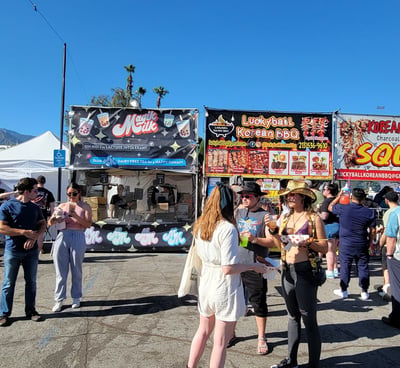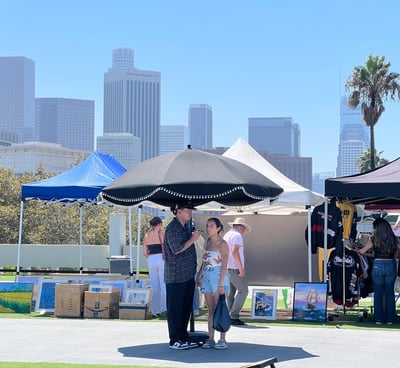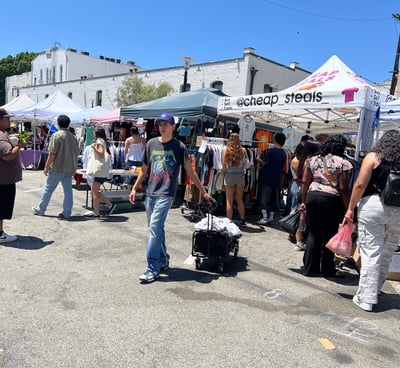The Joy of Community Flea Markets: Family Fun, Food, and Sustainability
Imagine a sunny weekend morning where the air buzzes with excitement, the aroma of delicious food wafts through the breeze, and laughter echoes as families explore a vibrant marketplace. Welcome to the world of community flea markets—a delightful blend of entertainment, culinary adventures, and eco-friendly shopping. These bustling bazaars offer more than just a place to find unique treasures; they serve as communal hubs that foster family bonding, support local economies, and promote sustainable practices. Let's journey through the lively lanes of flea markets across the United States and discover their multifaceted charm.
STATE & LOCAL GOVERNMENTWEEKEND FUNCOMMUNITY
Dr. Shawn Granger
3/1/20255 min read


A Family Affair: Fun and Food at Flea Markets
Community flea markets are synonymous with family-friendly entertainment. They provide a safe and engaging environment where individuals of all ages can come together to explore, play, and indulge in culinary delights.
Entertainment for All Ages
Many flea markets go beyond shopping, offering many activities to entertain the entire family. For instance, the Anaheim Indoor Marketplace in California hosts free live entertainment every weekend, featuring live music, dancing, ballet folklorico, and karaoke sessions. This lively atmosphere transforms a simple shopping trip into a memorable family outing (Anaheim Indoor Marketplace, n.d.).
Similarly, the Melrose Trading Post in Los Angeles dedicates Sunday mornings to family fun with "Melrose Mornings." Activities include storytime sessions in the garden and community yoga and sound bath experiences on the main stage, fostering a sense of community and well-being among attendees (Melrose Trading Post, n.d.).
Culinary Delights
Food is an integral part of the flea market experience. Vendors offer diverse culinary options, from traditional favorites to exotic delicacies, ensuring that there's something to satisfy every palate. For example, the San José Flea Market features a quarter-mile-long produce row, providing fresh fruits and vegetables alongside various food stalls serving delectable dishes. This setup allows families to enjoy wholesome meals while supporting local food producers (San José Flea Market, n.d.).
When indulging in flea market fare, it's essential to consider food safety. The Centers for Disease Control and Prevention (CDC) recommends observing vendors for clean workstations, proper handwashing facilities, and appropriate food handling practices, such as using gloves or tongs. Ensuring these standards helps maintain a safe and enjoyable dining experience (CDC, n.d.).
Sustainability Through Vintage: Reducing Waste One Treasure at a Time
Beyond entertainment and food, flea markets play a significant role in promoting environmental sustainability. By facilitating the reuse of vintage and second-hand items, they help reduce waste and conserve resources.
Extending the Lifespan of Goods
Purchasing vintage items at flea markets extends the life of products that might otherwise end up in landfills. This practice reduces waste and lessens the demand for new production, which often consumes substantial natural resources. According to the Environmental Protection Agency (EPA), textile waste occupies nearly 5% of all landfill space. By choosing second-hand clothing and goods, consumers can help decrease this statistic significantly (EPA, n.d.).
Reducing Carbon Footprint
Producing new goods, particularly in the fashion industry, contributes to significant carbon emissions. The United Nations Environment Programme (UNEP) reports that the fashion industry is responsible for 10% of global carbon emissions, surpassing the combined emissions from international flights and maritime shipping. By opting for vintage fashion and goods, shoppers can reduce their carbon footprint and promote a more sustainable lifestyle (UNEP, n.d.).
Supporting the Circular Economy
Flea markets embody the principles of the circular economy, where products are reused, repaired, and recycled, creating a closed-loop system that minimizes waste. As noted by Traders Village, a popular flea market in Texas, "Shopping in flea markets decreases waste by diverting items from landfills, giving them a new purpose" (Traders Village, n.d.). This approach benefits the environment and supports local vendors and artisans who rely on the market for their livelihoods.
Notable Flea Markets Across the United States
The United States boasts a rich tapestry of flea markets, each offering unique experiences and treasures. Here are some notable markets that exemplify the charm and diversity of these communal gatherings:
Rose Bowl Flea Market – Pasadena, California
Celebrated as one of the most famous flea markets globally, the Rose Bowl Flea Market features over 2,500 vendors and attracts approximately 20,000 buyers monthly. Shoppers can find an array of antiques, vintage clothing, and collectibles, making it a haven for treasure hunters and enthusiasts (R.G. Canning Enterprises, n.d.).
127 Yard Sale – Multiple States
Dubbed "The World's Longest Yard Sale," the 127 Yard Sale spans 690 miles from Michigan to Alabama. This annual event began in 1987 and features thousands of vendors along U.S. Route 127, offering various items from vintage goods to unique collectibles. It's a cultural phenomenon that brings communities together and provides a platform for sustainable shopping (The New Yorker, 2024).
Mile High Flea Market – Denver, Colorado
Operating year-round, the Mile High Flea Market offers a unique shopping experience with a vast selection of second-hand items. The market emphasizes sustainability, noting that "shopping at Mile High Flea Market is a sustainable choice that benefits you and the environment" (Mile High Flea Market, n.d.). Visitors can find everything from vintage clothing to handcrafted goods, all while supporting local businesses and reducing waste.
San José Flea Market – San Jose, California
Established in 1960, the San José Flea Market spans 120 acres and features a quarter-mile-long produce row offering fresh fruits and vegetables. With over 2,000 vendors, the market provides various goods, from vintage items to everyday necessities. It's a vibrant community hub where families can enjoy live music, delicious food, and a unique shopping experience (San José Flea Market, n.d.).
Melrose Trading Post – Los Angeles, California
Held every Sunday, the Melrose Trading Post is a curated market featuring handcrafted artisan goods, vintage fashion, and eclectic art pieces. The market fosters a sense of community by offering family-friendly activities, such as story time sessions and yoga classes, making it a popular destination for locals and tourists (Melrose Trading Post, n.d.).
The Social Fabric of Flea Markets
Beyond the tangible benefits of entertainment, food, and sustainability, flea markets weave a rich social tapestry that strengthens community bonds and fosters cultural exchange.
A Meeting Ground for Diverse Cultures
Flea markets serve as melting pots where people from various backgrounds converge, share stories, and exchange cultural artifacts. This diversity enriches the shopping experience, offering patrons a chance to learn about different traditions and histories through the items on display.
Supporting Local Economies
Flea markets stimulate local economies by providing a platform for small businesses, artisans, and independent vendors. Shoppers' investments directly support entrepreneurs, enabling them to thrive and contribute to the community's economic vitality.
Preserving History Through Objects
Each vintage item at a flea market carries a story, a piece of history waiting to be discovered. By purchasing these items, shoppers become custodians of the past, preserving memories and traditions for future generations.
Conclusion
Community flea markets are more than just marketplaces; they are vibrant ecosystems that offer family-friendly entertainment, diverse culinary experiences, and sustainable shopping options.
References
Anaheim Indoor Marketplace. (n.d.). Entertainment & events. Retrieved from https://www.anaheimindoormarketplace.com
Centers for Disease Control and Prevention. (n.d.). Food safety tips for outdoor markets and fairs. Retrieved from https://www.cdc.gov/foodsafety
Environmental Protection Agency. (n.d.). Textile waste reduction strategies. Retrieved from https://www.epa.gov/sustainable-management-textiles
Melrose Trading Post. (n.d.). About us. Retrieved from https://www.melrosetradingpost.org
Mile High Flea Market. (n.d.). Why shopping at flea markets is sustainable. Retrieved from https://www.milehighfleamarket.com
R.G. Canning Enterprises. (n.d.). Rose Bowl Flea Market. Retrieved from https://www.rgcshows.com
San José Flea Market. (n.d.). Market overview and vendor listings. Retrieved from https://www.sjfm.com
The New Yorker. (2024). The world's longest yard sale and the culture of flea markets. Retrieved from https://www.newyorker.com
Traders Village. (n.d.). How flea markets help reduce waste and support communities. Retrieved from https://www.tradersvillage.com
United Nations Environment Programme. (n.d.). Fashion and sustainability: Reducing carbon emissions through second-hand shopping. Retrieved from https://www.unep.org






